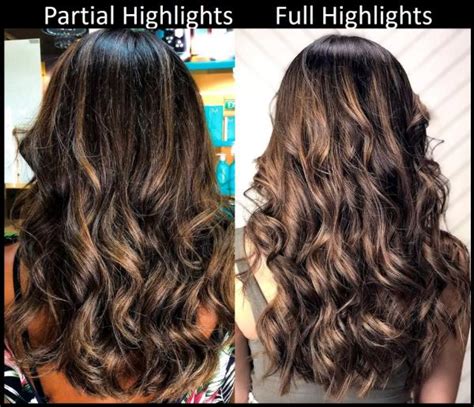Introduction

Enhance your locks with highlights, a transformative hair coloring technique that adds definition and dimension to your strands. Whether you opt for subtle partial highlights or a bold, full-coverage look, understanding the differences between these two methods is crucial for achieving your desired aesthetic. This comprehensive guide will explore the nuances of partial vs full highlights, empowering you to make an informed decision that complements your style and hair goals.
Partial Highlights: A Natural, Sun-Kissed Look
Partial highlights, also known as babylights or soft highlighting, involve adding color to select strands of hair, typically around the face and crown. This technique creates a natural, sun-kissed effect, as if your hair has been lightened by the sun’s golden rays.
Benefits of Partial Highlights:
- Subtle and Natural: Partial highlights blend seamlessly with your natural hair color, providing a low-maintenance way to enhance your look.
- Customized: The placement of the highlights can be tailored to suit your facial features, creating a flattering frame for your face.
- Less Damaging: Partial highlights only involve lightening a portion of your hair, reducing the potential for chemical damage compared to full highlights.
- Versatile: Partial highlights can complement any hair color and texture, adding depth and dimension to fine hair or creating a subtle contrast on darker hair.
Full Highlights: A Bold, Dramatic Transformation
Full highlights involve bleaching or lightening most or all of your hair. This technique creates a striking, high-contrast look that can completely change your hair’s overall tone.
Benefits of Full Highlights:
- Dramatic Transformation: Full highlights can dramatically alter your hair color, allowing you to experiment with new shades and create a bold, eye-catching look.
- Increased Brightness: Full highlights maximize the brightness and lightness of your hair, creating a stunning effect.
- Versatile: Full highlights can be customized to suit your desired level of contrast, from subtle to extreme.
- Can Correct Uneven Hair Color: Full highlights can help to correct uneven or faded hair color, creating a more uniform and polished look.
Comparing Partial vs Full Highlights
To help you make an informed decision, here is a table comparing the key differences between partial and full highlights:
| Feature | Partial Highlights | Full Highlights |
|---|---|---|
| Coverage | Select strands of hair | Most or all of the hair |
| Effect | Natural, sun-kissed look | Bold, dramatic transformation |
| Maintenance | Lower maintenance, less frequent touch-ups | Higher maintenance, more frequent touch-ups |
| Damage | Less damaging | More damaging |
| Versatility | Complements most hair colors and textures | Versatile, suitable for various styles and colors |
Choosing the Right Technique for You
The best way to choose between partial and full highlights is to consider your desired look and hair health.
- If you want a subtle, low-maintenance way to brighten your hair and enhance your natural color, partial highlights are a great option.
- If you are ready for a bold, dramatic transformation and are willing to commit to regular upkeep, full highlights may be a better choice.
Effective Strategies for Stunning Highlights
- Consult a Professional: Seek the expertise of a skilled stylist to ensure precise application and avoid damaging your hair.
- Choose the Right Color: Select a color that complements your natural hair tone and desired level of contrast.
- Protect Your Hair: Use heat protectants and hair treatments to minimize damage during and after highlighting.
- Regular Touch-Ups: Maintain your highlights by scheduling regular touch-ups to prevent fading and preserve the desired look.
How-To: A Step-by-Step Approach to Highlights
Whether you opt for partial or full highlights, here is a simplified step-by-step approach to guide you through the process:
Step 1: Consultation and Planning
Discuss your desired look with your stylist and determine the best highlighting technique and color combination for your hair.
Step 2: Hair Preparation
Wash and dry your hair to remove any products or buildup. Section your hair into manageable parts for easier application.
Step 3: Application
Using a brush or comb, apply the highlighting product to the selected strands of hair (for partial highlights) or most of the hair (for full highlights).
Step 4: Processing
Allow the highlighting product to process for the recommended time, typically 30-60 minutes.
Step 5: Toning and Conditioning
After rinsing out the highlighting product, apply a toner or color-depositing conditioner to enhance the color and neutralize unwanted tones.
Step 6: Styling
Style your hair as desired to showcase your new highlights.
Innovative Applications: Beyond Traditional Highlights
The realm of highlights extends beyond traditional methods, offering a range of creative opportunities to personalize your hair.
- Root Smudging: Create a subtle transition between your natural hair color and the highlights by smudging the roots to blend the two tones.
- Balayage: A freehand highlighting technique that creates a natural, painted-on effect with soft, blended highlights.
- Foilyage: A combination of balayage and traditional foiling, resulting in a striking blend of light and dark tones.
- Reverse Highlights: This technique involves darkening certain strands of hair to add depth and contrast to your overall look.
Conclusion
Partial vs full highlights offer distinct advantages depending on your desired look and hair goals. Whether you prefer a subtle, sun-kissed effect or a bold, dramatic transformation, understanding the differences between these techniques empowers you to make an informed decision. By consulting a professional stylist, choosing the right color, and following effective strategies, you can achieve stunning highlights that enhance your beauty and boost your confidence. Embrace the transformative power of highlights and unleash your inner radiance!
